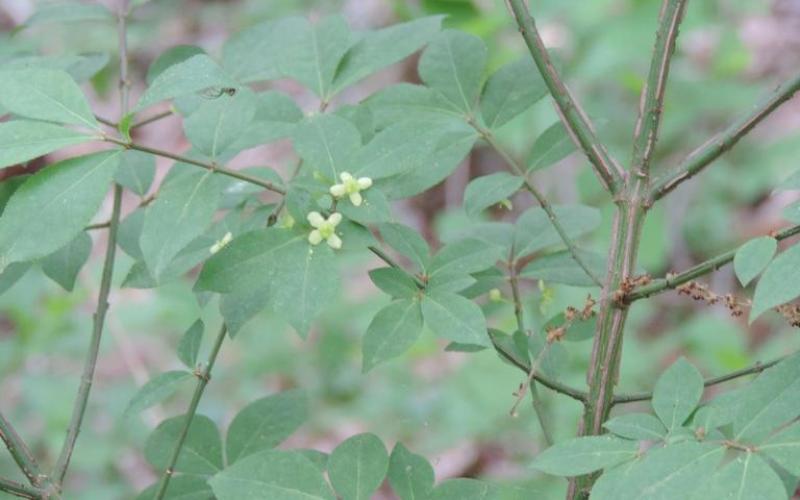Common name: Winged burning bush
Scientific name: Euonymus alatus (Thunb.) Sieb.
Synonyms: Burning bush, winged euonymus, winged spindle tree
Related species: Introduced species: E. fortuneii, E. europaeus, E. hamitonianus. Native species: E. atropurpureus.
Legal status
Propagation and sale of this plant are prohibited in Minnesota. Transportation is only allowed when in compliance with Minnesota Statute 18.82. Although Restricted Noxious Weeds are not required to be controlled or eradicated by law, landowners are strongly encouraged to manage these invasive plants on their properties in order to reduce spread into new areas.
Background
Winged burning bush was introduced to North America in the mid-1800s for use as an ornamental shrub. The bright red fall foliage makes it an attractive landscape plant and it has been commonly planted as hedges and in foundation plantings. Shade tolerance and good form without much pruning are also important characteristics that make winged burning bush a valuable and popular plant.
Description
- Winged burning bush is a woody perennial shrub averaging 5-10 feet tall. It can form multiple stems or a single stem that branches close to the ground.
- It is a member of the Celastraceae (Bittersweet) family.
- Leaves are dark green, opposite, and occur in pairs. Leaves are 1-2.5 inches long and 0.5-1.25 inches across, elliptic, and finely serrated. Leaves have very short petioles and are hairless. The leaves turn brilliant red in the fall in full sun and pink in heavy shade before abscising.
- Young branches develop reddish, corky “wings” giving this shrub a distinctive appearance.
- Clusters of 3 flowers develop in leaf axils. Fruits mature into red capsules that eventually split open exposing 1 – 4 bright orange to red berry-like arils containing two seeds each.
Habitat
Winged burning bush grows in full sun or full shade, adaptable to may growing conditions. It has been documented as invading open disturbed areas such as abandoned fields, pastures, forest edges, roadsides, and yards.
Means of spread and distribution
Plants reproduce by seed which are spread by wildlife. It is a prolific seed producer and germinate close to the parent plant, creating a carpet of seedlings. It has also been widely planted as a landscape plant throughout North America. Additionally, it transplants easily and grows well in full shade and full sun.
Impact
It is very shade tolerant, forms a dense canopy, and reduces native plant diversity in understory. It is a prolific seed producer, seeds germinate readily, and the seeds are disbursed by wildlife. It forms dense thickets where hundreds of seedlings form a carpet, outcompeting native plant species. It has a mat-like root system, and shades and crowds out other vegetation.
Prevention and management
- Avoid spreading winged burning bush by learning to recognize it and not planting it. Do not collect or use the fruiting stems for ornamental purposes.
- For all management options, infested sites will need to be monitored and treated repeatedly until the seedbanks are depleted.
- Foliar or cut stump herbicide applications can be effective. For specific herbicide recommendations, check with your local University of Minnesota Extension personnel, co-op, or certified landscape care expert. There are several businesses throughout the state with certified herbicide applicators that can be hired to perform chemical applications.



